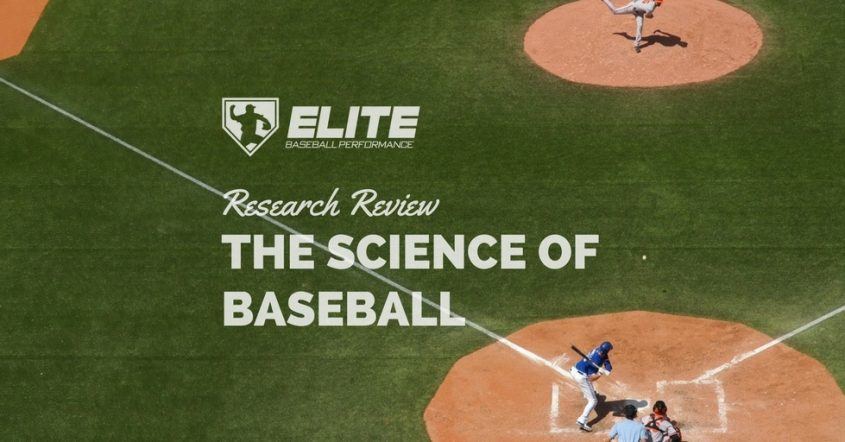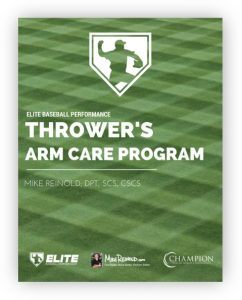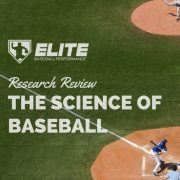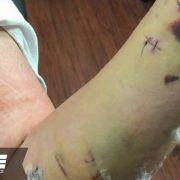Is Rotator Cuff Strength the Key to Preventing Tommy John Injuries?
I like simple studies that answer complex answers. A recent report in the International Journal of Sports Physical Therapy has shown the baseball pitchers with Tommy John injuries have weaker rotator cuff strength than healthy players.
This has long been studied and shown previously but the I really liked how the authors conducted this study. Two things stand out to me from these results that have considerable implications. Baseball players with Tommy John injuries had:
- 7% deficit in ER rotator cuff strength compared to their non-throwing arm. Healthy players had no deficit between their shoulders.
- 30% deficit in ER rotator cuff strength compared to the throwing arm of healthy players.
So, players with Tommy John injuries were weaker in general and showed specific throwing arm weakness. I’ve always said that shoulder strength and mobility is the key to reducing these Tommy John injuries, these results completely support the need for rotator cuff strength.
 Download Our Free Throwers Arm Care Program
Download Our Free Throwers Arm Care Program
So it’s pretty obvious that we should be performing a shoulder program. I’ve recently put together a free arm care program for EBP that you can perform to get your shoulder and forearm strong, and hopefully prevent some of these Tommy John injuries.
Baseball Players With Ulnar Collateral Ligament Tears Demonstrate Decreased Rotator Cuff Strength Compared To Healthy Controls
Background: Ulnar Collateral Ligament (UCL) tears are common in baseball players. Alterations in rotator cuff strength are believed to be associated with injury to the shoulder and/or elbow in baseball players.
Hypothesis/Purpose: Baseball players diagnosed with a UCL tear will demonstrate decreased internal (IR) and external rotation (ER) force as an indication of isometric muscular strength in the throwing arm compared to IR and ER force of the throwing arm in healthy baseball players. The purpose of this study was to examine isometric IR and ER strength of the shoulder in baseball players with UCL tears at the time of injury compared to healthy baseball players.
Study Design: Case‐control study design
Methods: Thirty‐three of the participants were diagnosed with a UCL tear and thirty‐three were healthy, age‐ and positioned‐matched controls. All of the participants played baseball at either the high school or collegiate level and volunteered for the study. Isometric rotator cuff strength measurements for internal (IR) and external rotation (ER) were performed with the arm held to the side at 0 ° of shoulder abduction. All measurements were taken bilaterally and the means of the throwing and non‐throwing arms for IR and ER in the UCL group were compared to the means of the throwing and non‐throwing arms in the healthy group. One‐way ANOVAs were used to calculate differences between groups (p < 0.05).
Results: Baseball players with UCL tears demonstrated significant rotator cuff strength deficits on their throwing arm IR (p < .001) and ER (p < .001) compared to throwing arm IR and ER in the Healthy (UCL IR = 131.3 ± 31.6 N; Healthy IR = 174.9 ± 20.7 N) (UCL ER = 86.4 ± 18.3 N; Healthy ER = 122.3 ± 18.3 N). On the non‐throwing arm, the UCL group was weaker in both IR (135.0 ± 31.1 N; p < .001) and ER (93.4 ± 22.8 N; p < .001) than IR (172.1 ± 24.1 N) and ER (122.3 ± 19.1 N) in the Healthy group.
Conclusion: Participants with a UCL tear exhibit lower force values as an indication of isometric rotator cuff strength in both the throwing and non‐throwing arms than a healthy cohort.Int J Sports Phys Ther . 2015 Aug; 10(4): 476–481. BASEBALL PLAYERS WITH ULNAR COLLATERAL LIGAMENT TEARS DEMONSTRATE DECREASED ROTATOR CUFF STRENGTH COMPARED TO HEALTHY CONTROLS Copyright © 2015 by the Sports Physical Therapy Section Abstract Background Ulnar Collateral Ligament (UCL) tears are common in baseball players.
Mike Reinold
Latest posts by Mike Reinold (see all)
- 3 Ways Baseball Pitchers Can Use a Radar Gun to Enhance Performance - April 16, 2019
- 3 Things Baseball Players Need to Develop Elite Pitching Performance - January 15, 2018
- How to Get Your Arm Loose When Throwing Indoors - November 14, 2017










Hey Mike-
Thanks for the post. I have always thought that getting the cuff as strong as possible is important from an injury prevention perspective, but I’m wondering what you think the potential link is, as the cuff doesn’t have a direct stabilizing effect on the elbow. Do you think it is just that cuff weakness or lack of endurance may lead to faulty mechanics, or do you think there is something else? Looking forward to your thoughts! Thanks.
Hi Todd, I think that strength of the shoulder plays an important role in the positioning of the arm, which would increase stress on the elbow.